A Case Study on Surrounding Rock Deformation Control Technology of Gob-Side Coal-Rock Roadway in Inclined Coal Seam of a Mine in Guizhou, China
Abstract
:1. Introduction
2. Engineering Background
2.1. Overview of the Mine
2.2. Deformation Characteristics of Roadway under Original Support Scheme
- (1)
- Roof subsidence and support failure
- (2)
- Broken sillar falling
- (3)
- Serious floor heave
3. CUSG Support Method
3.1. Selection of Support Method
3.2. Numerical Simulation
3.3. Analysis of Numerical Simulation Results
4. The Slurry Diffusion Theory of Hollow Grouted Anchor Cable (HGC)
5. Engineering Application
6. Conclusions
Author Contributions
Funding
Institutional Review Board Statement
Informed Consent Statement
Data Availability Statement
Conflicts of Interest
References
- Xu, Y.; Chen, J.; Bai, J.B. Control of floor heaves with steel pile in gob-side entry retaining. Int. J. Min. Sci. Technol. 2016, 26, 527–534. [Google Scholar] [CrossRef]
- Hua, X.Z.; Li, Y.F. Mechanics analysis on floor deformation of gob-side entry retaining and prevention and control of floor heave. J. China Coal Soc. 2016, 41, 1624–1631. [Google Scholar]
- Ye, G.X.; Zhu, Q.J.; Li, S.X.; Yu, Z.X. Development and application of composite filling body in gob-side entry retaining with 1000 m-plus deep coal mine. J. Min. Saf. Eng. 2016, 33, 787–794. [Google Scholar]
- Sun, X.M.; Liu, X.; Liang, G.F.; Wang, D.; Jiang, Y.L. Key parameters of gob-side entry retaining formed by roof cut and pressure releasing in thin coal seams. Chin. J. Rock Mech. Eng. 2014, 33, 1449–1456. [Google Scholar]
- Han, C.L.; Zhang, N.; Ran, Z.; Gao, R.; Yang, H.Q. Superposed disturbance mechanism of sequential overlying strata collapse for gob-side entry retaining and corresponding control strategies. J. Cent. South Univ. 2018, 25, 2258–2271. [Google Scholar] [CrossRef]
- Xie, S.R.; Li, S.J.; Huang, X.; Sun, Y.D.; Yang, J.H.; Qiao, S.X. Surrounding rock principal stress difference evolution law and control of gob-side entry driving in deep mine. J. China Coal Soc. 2015, 40, 2355–2360. [Google Scholar]
- He, M.C.; Gao, Y.B.; Yang, J.; Gong, W.L. An innovative approach for gob-Side entry retaining in thick coal seam longwall mining. Energies 2017, 10, 1785. [Google Scholar] [CrossRef] [Green Version]
- Sun, X.M.; Li, G.; Song, P.; Miao, C.Y.; Zhao, C.W. Application research on gob-side entry retaining methods in no. 1200 working face in Zhongxing mine. Geotech. Geol. Eng. 2019, 37, 185–200. [Google Scholar]
- Gao, L.; Liu, P.Z.; Zhang, P.D.; Wu, G.Y.; Kang, X.T. Influence of Fracture Types of Main Roof on the Stability of Surrounding Rock of the Gob-Side Coal-Rock Roadway in Inclined Coal Seams and Its Engineering Application. Goal Geology & Exploration. 2022. Available online: https://kns.cnki.net/kcms/detail/61.1155.p.20220416.0838.002.html (accessed on 5 April 2022).
- Shi, X.S.; Jing, H.W.; Zhao, Z.L.; Gao, Y.; Zhang, Y.C.; Bu, R.D. Physical experiment and numerical modeling on the failure mechanism of gob-side entry driven in thick coal seam. Energies 2020, 13, 5425. [Google Scholar] [CrossRef]
- Hou, C.J.; Li, X.H. Stability principle of big and small structures of rock surrounding roadway driven along goaf in fully mechanized top coal caving face. J. China Coal Soc. 2001, 26, 1–7. [Google Scholar]
- Han, G.; Dou, L.M.; Zhang, Y.; Li, X.D.; Wang, Q.; Lv, Y.L. Influence mechanism and prevention technology of dynamic manifestation of roadway along goaf. J. Min. Saf. Eng. 2021, 38, 730–748. [Google Scholar]
- Zhang, L.; Zhao, J.; Zang, C.W.; Wang, S.L. An innovative approach for gob-side entry retaining by roof cutting in steeply pitching seam longwall mining with hard roof: A case study. Min. Met. Explor. 2020, 37, 1079–1091. [Google Scholar] [CrossRef]
- Wang, M.; Bai, J.B.; Wang, X.Y.; Chen, B.; Han, Z.T. Stability and control technology of overlying structure in gob-side entry driving roadways of deep inclined coal seam. J. Min. Saf. Eng. 2015, 32, 426–432. [Google Scholar]
- Wu, H.; Zhu, C.Q.; Li, Q.F. Study on surrounding rock stability mechanism of gob-side entry retaining with prefabricated fracture. Adv. Civ. Eng. 2021, 2021, 5819672. [Google Scholar] [CrossRef]
- Wang, Z.Q.; Wang, P.; Lv, W.Y.; Shi, L.; Su, Z.H.; Wu, C.; Yu, F. Mechanism and control of asymmetric floor heave in gob-side entry. J. Min. Saf. Eng. 2021, 38, 215–226. [Google Scholar]
- Bai, J.B.; Wang, W.J.; Hou, C.J.; Huang, H.F. Control mechanism and support technique about gateway driven along goaf in fully mechanized top coal caving face. J. China Coal Soc. 2000, 25, 478–481. [Google Scholar]
- Qin, T.; Ren, K.; Jiang, C.; Duan, Y.W.; Liu, Z.; Wang, L. Distribution law of mining stress of the gob-side entry retaining in deep mining thin coal seam. Adv. Civ. Eng. 2021, 2021, 5589948. [Google Scholar] [CrossRef]
- Basarir, H.; Oge, I.; Aydin, O. Prediction of the stresses around main and tail gates during top coal caving by 3D numerical analysis. Int. J. Rock Mech. Min. Sci. 2015, 76, 88–97. [Google Scholar] [CrossRef]
- Jiang, W.; Ju, W.J.; Wang, Z.L.; Zhang, Z.; Shi, M. Characteristics of overburden stress distribution and rational pillar width determination of gob-side roadway with thick and hard basic roof in fully mechanized top coal caving workface. J. Min. Saf. Eng. 2020, 37, 1142–1151. [Google Scholar]
- Wilson, A. The stability of underground workings in the soft rocks of the coal. Int. J. Min. Eng. 1983, 1, 91–187. [Google Scholar] [CrossRef]
- Shabnimashcool, M.; Li, C.C. Numerical modeling of longwall mining and stability analysis of the gates in a mine. Int. J. Rock Mech. Min. Sci. 2012, 51, 24–34. [Google Scholar] [CrossRef]
- Zhao, G.Z.; Ma, Z.G.; Sun, K.; Fan, J.Q.; Li, K. Research on deformation controlling mechanism of the narrow pillar of roadway driving along next goaf. J. Min. Saf. Eng. 2010, 27, 517–521. [Google Scholar]
- Arthur, F.A.; Zeshan, H.; Tiile, R.N. Pillar stability analysis at Missouri S&T dolomitic limestone experimental mine Proc. In Proceedings of the 50th US Rock Mechanics/Geomechanics Symp, Houston, TX, USA, 26–29 June 2016. [Google Scholar]
- Zheng, X.G.; An, T.L.; Guo, Y.; Liu, C.C.; Cheng, X. Surrounding rock control mechanism and engineering application of in-situ coal pillar in gob-side entry retaining. J. Min. Saf. Eng. 2018, 35, 1091–1098. [Google Scholar]
- Tian, Z.J.; Zhang, Z.Z.; Deng, M.; Yan, S.; Bai, J.B. Gob-side entry retained with soft roof, floor, and seam in thin coal seams: A Case Study. Sustainability 2020, 12, 1197. [Google Scholar] [CrossRef] [Green Version]
- Zhang, N.; Han, C.L.; Kan, J.G.; Zheng, X.G. Theory and practice of surrounding rock control for pillarless gob-side entry retaining. J. China Coal Soc. 2014, 39, 1635–1641. [Google Scholar]
- He, F.L.; Gao, F.; Sun, Y.J.; Li, S.J.; Song, B.H.; Yang, Y.F. Multiple-cable-girder-truss asymmetric support mechanism and its application in the roadway of fully mechanized top coal caving face with narrow coal pillar. J. China Coal Soc. 2015, 40, 2296–2302. [Google Scholar]
- Peng, W.Q.; Zhu, H.; Wang, Q.; Peng, G. Study on safety control of large-section roadway with high stress and broken surrounding rock. Adv. Civ. Eng. 2021, 2021, 6686208. [Google Scholar] [CrossRef]
- Wang, K.; Wang, L.G.; Ren, B. Failure mechanism analysis and support technology for roadway tunnel in fault fracture zone: A Case Study. Energies 2021, 14, 3767. [Google Scholar] [CrossRef]
- Huang, W.H.; Zhang, K.M.; Tang, X.Y.; Zhao, Z.G.; Wan, H. Coking coals potential resources prediction in deep coal beds in Northern China. Energy Explor. Exploit. 2010, 28, 313–324. [Google Scholar] [CrossRef]
- Kong, D.Z.; Xiong, Y.; Cheng, Z.B.; Wang, N.; Wu, G.Y.; Liu, Y. Stability analysis of coal face based on coal face-support-roof-system in steeply inclined coal seam. Geomech. Eng. 2021, 25, 233–243. [Google Scholar]
- Zhang, P.D.; Gao, L.; Liu, P.Z.; Wang, Y.Y.; Liu, P.; Kang, X.T. Study on the influence of borehole water content on bolt anchoring force in soft surrounding rock. Shock. Vib. 2022, 2022, 2384626. [Google Scholar] [CrossRef]
- Gao, L.; Zhao, S.H.; Huang, X.F.; Ma, Z.Q.; Kong, D.Z.; Kang, X.T.; Han, S. Experimental Study on Surrounding Rock Characteristics of Gateway in Panjiang Mining Area. J. GZU. (Nat. Sci.) 2022. Available online: http://kns.cnki.net/kcms/detail/52.5002.N.20220412.0956.002.html (accessed on 13 April 2022).
- Shan, R.L.; Peng, Y.H.; Kong, X.S.; Xiao, Y.H.; Yuan, H.H.; Huang, B.; Zheng, Y. Research progress of coal roadway support technology at home and abroad. Chin. J. Rock. Mech. Eng. 2019, 38, 2377–2403. [Google Scholar]
- Kang, H.P.; Wang, J.H.; Lin, J. Study and applications of roadway support techniques for coal mines. J. China Coal Soc. 2010, 35, 1809–1814. [Google Scholar]
- Hua, X.Z. Development status and improved proposals on gob-side entry retaining support technology in China. Coal Sci. Technol. 2006, 34, 18–81. [Google Scholar]
- He, M.C.; Chen, S.Y.; Guo, Z.B.; Yang, J.; Gao, Y.B. Control of surrounding rock structure for gob-side entry retaining by cutting roof to release pressure and its engineering application. J. China Univ. Min. Technol. 2017, 46, 960–969. [Google Scholar]
- Bai, J.B.; Zhou, H.Q.; Hou, C.J.; Tu, X.Z.; Yue, D.Z. Development of support technology beside roadway in goaf-side entry retaining for next sublevel. J. China Univ. Min. Technol. 2004, 33, 183–186. [Google Scholar]
- Shimada, H.; Hamanaka, A.; Sasaoka, T.; Matsui, K. Behaviour of grouting material used for floor reinforcement in underground mines. Int. J. Min. Reclam. Environ. 2014, 28, 133–148. [Google Scholar] [CrossRef]
- Widmann, R. International society for rock mechanics commission on rock grouting. Int. J. Rock Mech. Min. Sci. Geomech. Abstr. 1996, 33, 803–847. [Google Scholar] [CrossRef]
- Lee, J.S.; Sagong, M.; Park, J.; Choi, I.Y. Experimental analysis of penetration grouting in umbrella arch method for tunnel reinforcement. Int. J. Rock Mech. Min. Sci. 2020, 130, 104346. [Google Scholar] [CrossRef]
- Salimiana, M.H.; Baghbanana, A.; Hashemolhosseinib, H.; Dehghanipoodeha, M.; Norouzic, S. Effect of grouting on shear behavior of rock joint. Int. J. Rock Mech. Min. Sci. 2017, 98, 159–166. [Google Scholar] [CrossRef]
- Lu, Y.L.; Wang, L.G.; Li, Z.L.; Sun, H.Y. Experimental Study on the Shear Behavior of Regular Sandstone Joints Filled with Cement Grout. Rock Mech. Rock Eng. 2017, 50, 1321–1336. [Google Scholar] [CrossRef]
- Wang, L.G.; Li, M.Y.; Wang, X.Z. Study of mechanisms and technology for bolting and grouting in special soft rock roadways under high stresses. Chin. J. Rock. Mech. Eng. 2005, 24, 2889–2893. [Google Scholar]
- Liu, Y.X.; Gao, M.S.; He, Y.L.; Yu, X.; Xu, D. Study of control technology about gob-side entry driving with top-coal caving in inclined extra-thick coal seam. J. China Univ. Min. Technol. 2021, 50, 1051–1059. [Google Scholar]
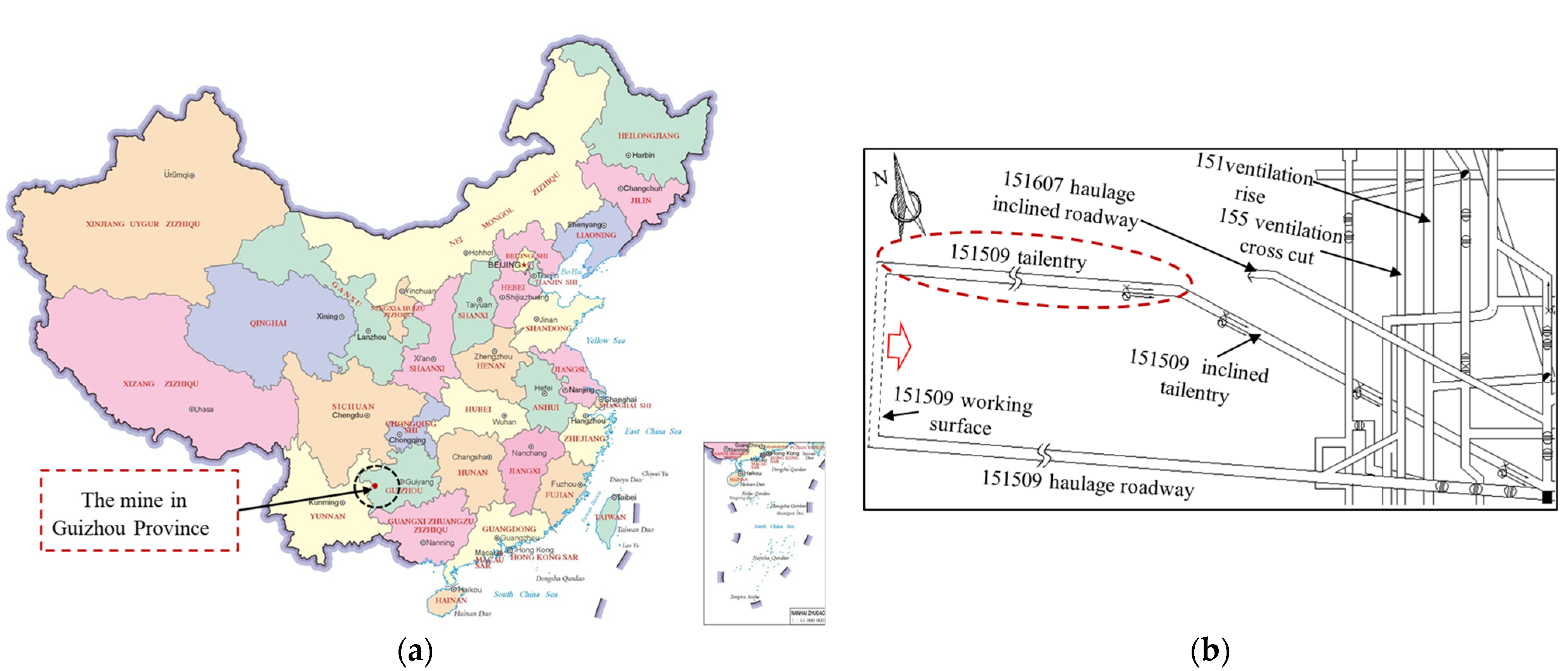
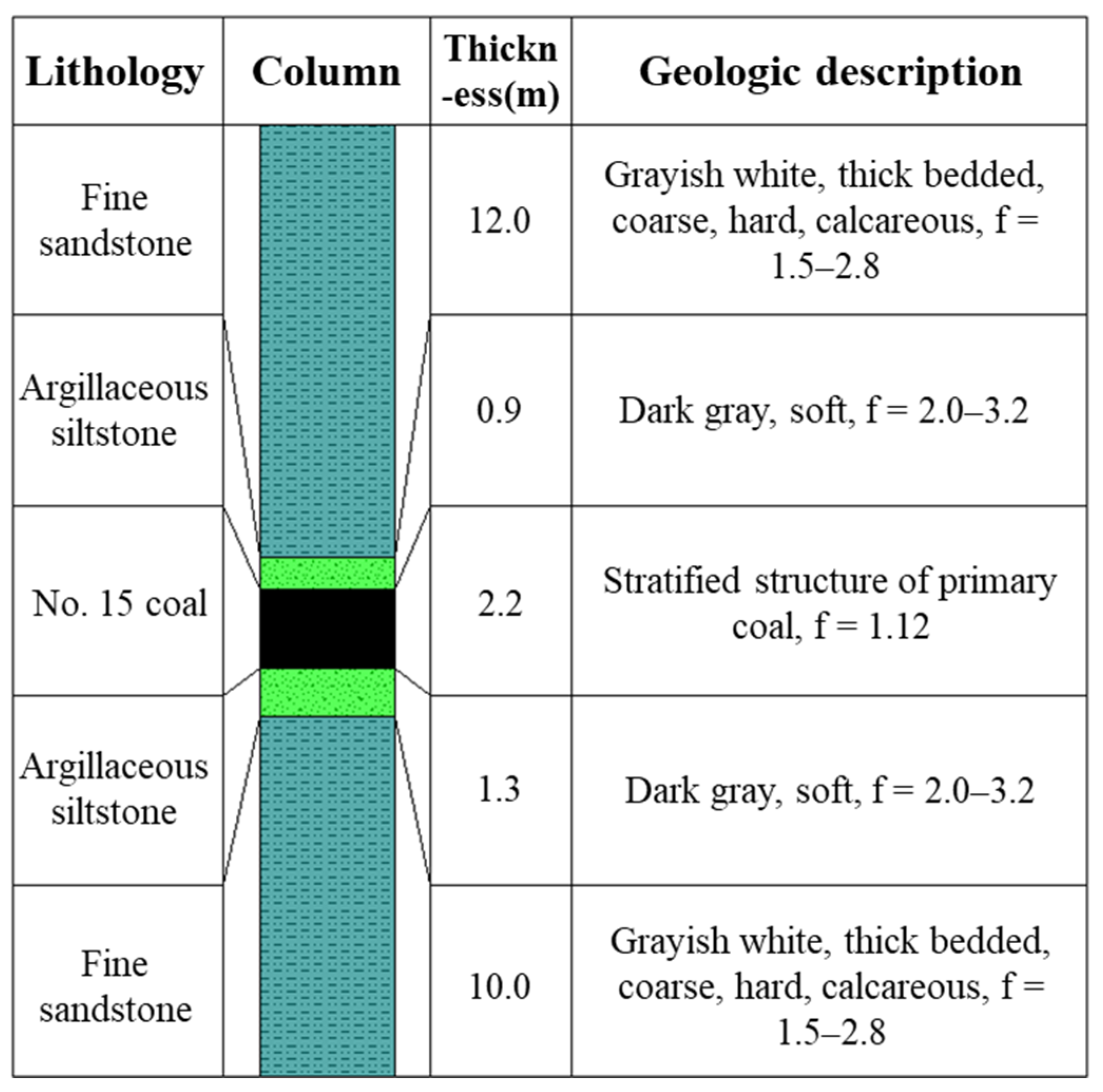


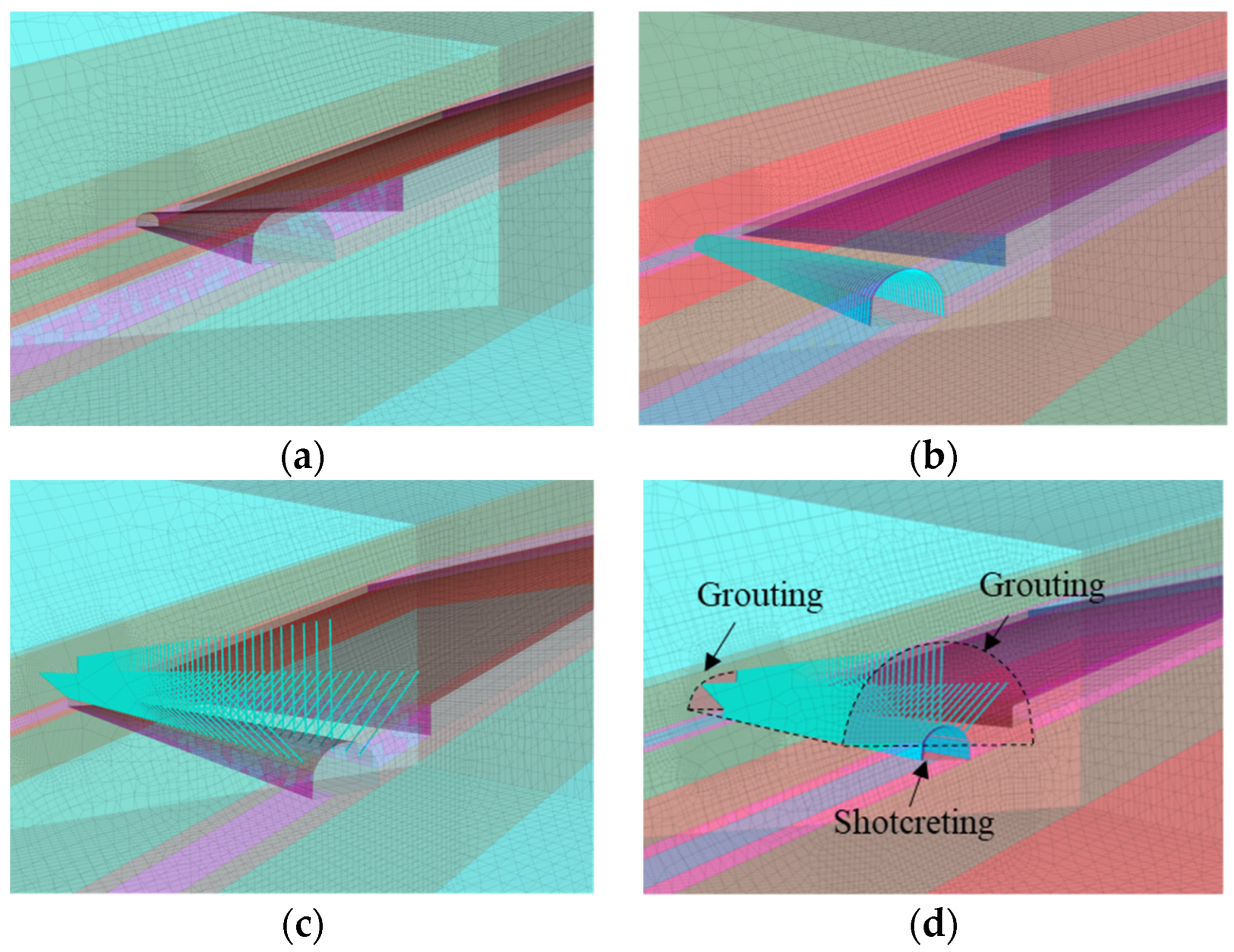
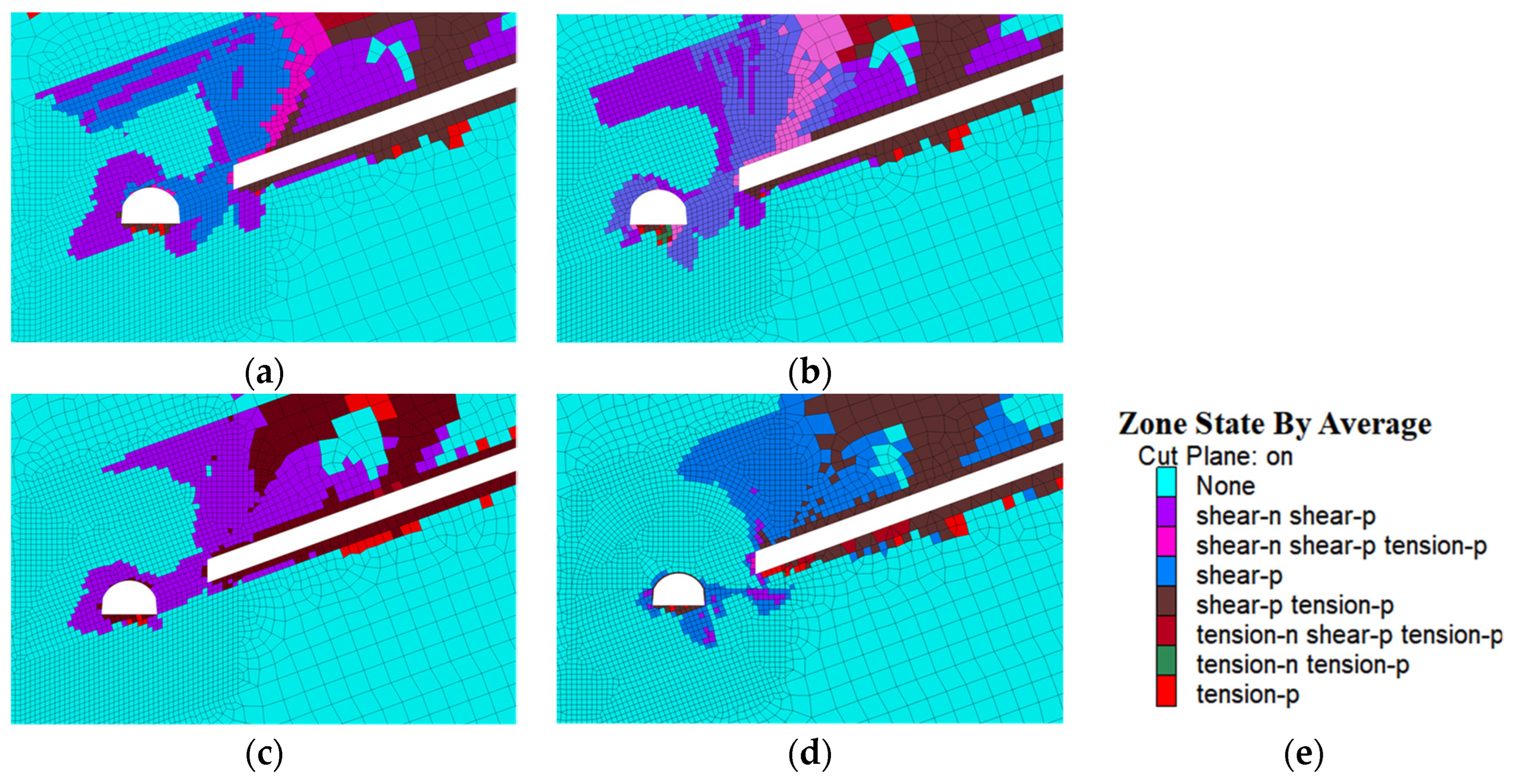
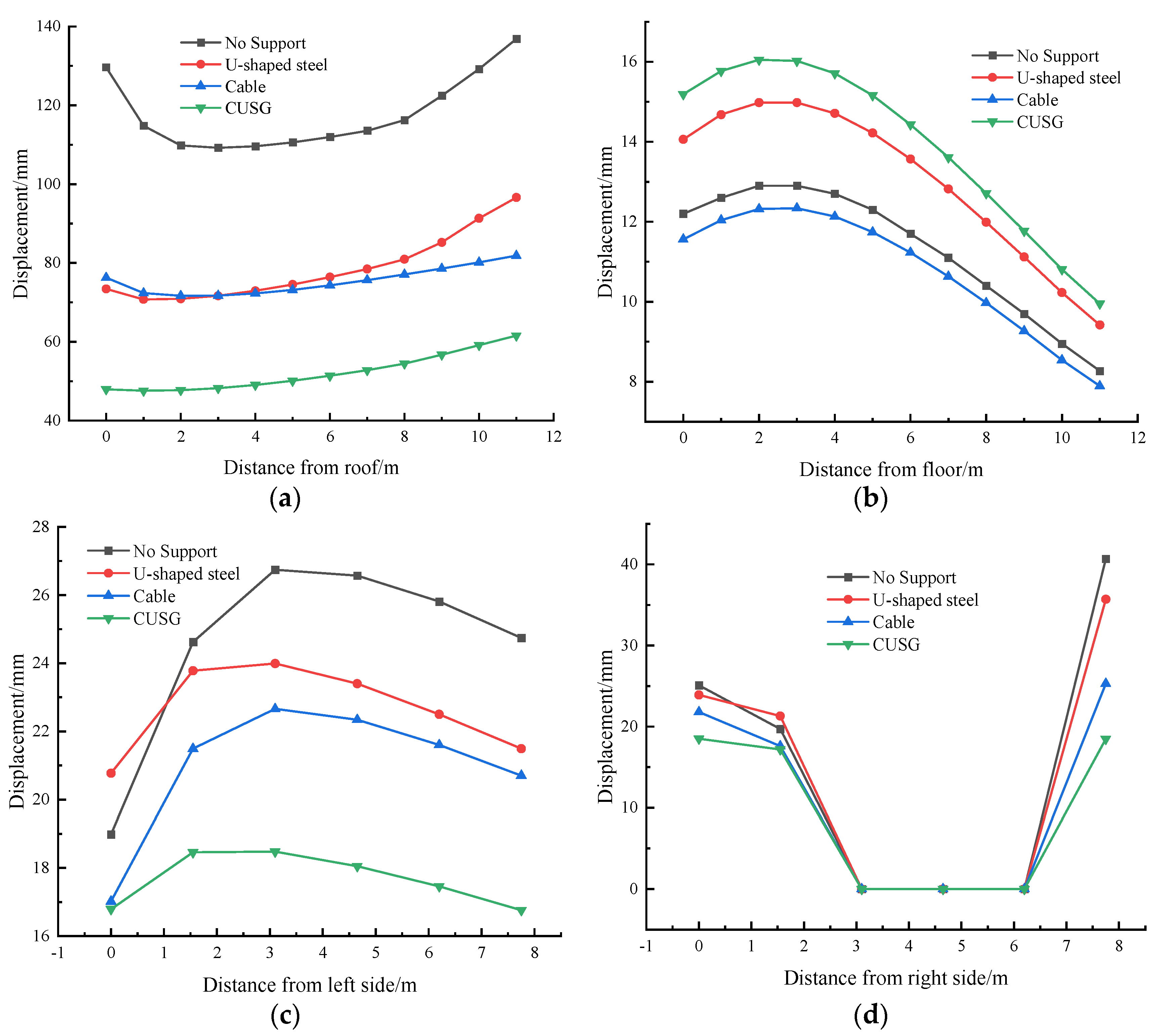
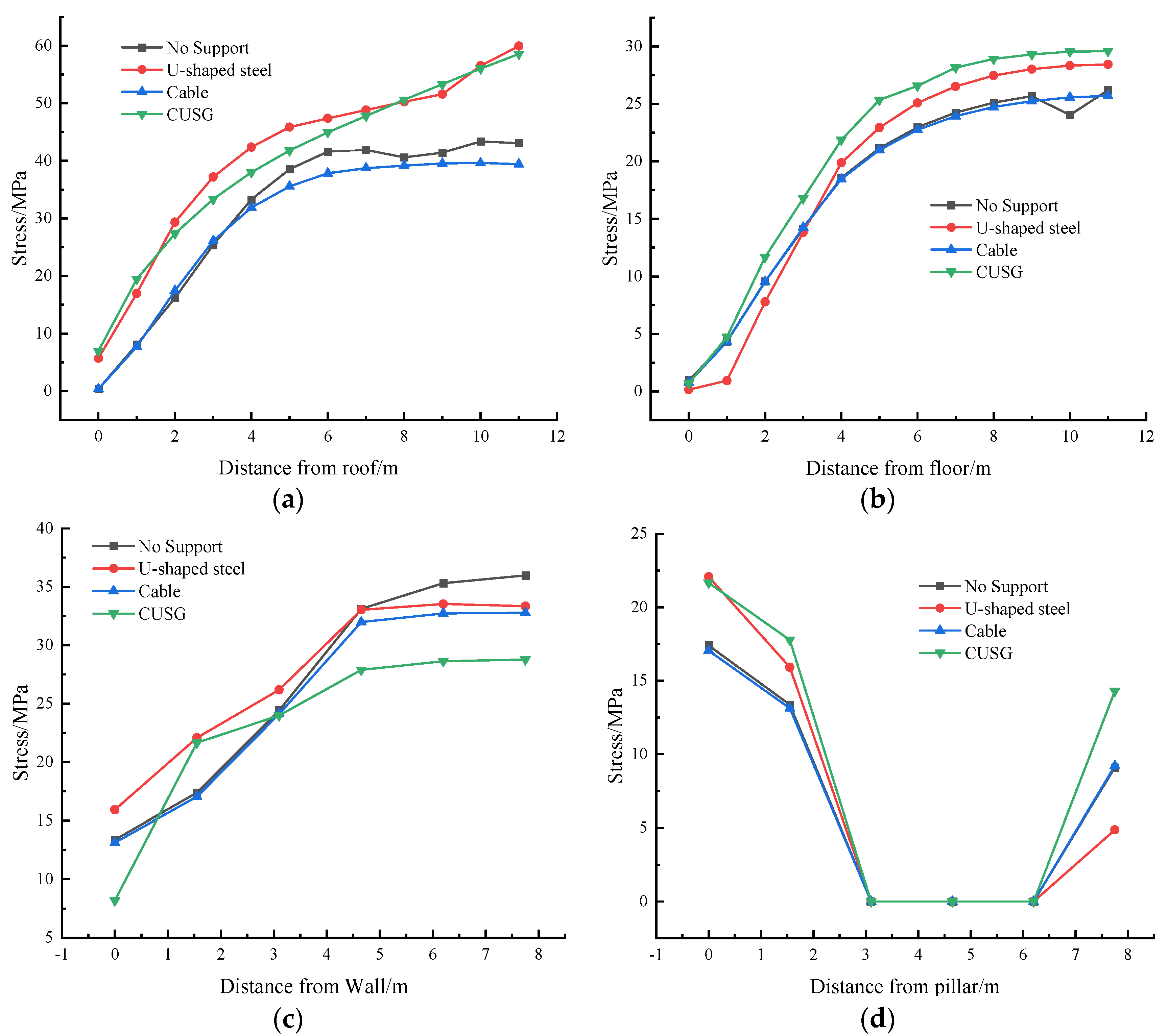

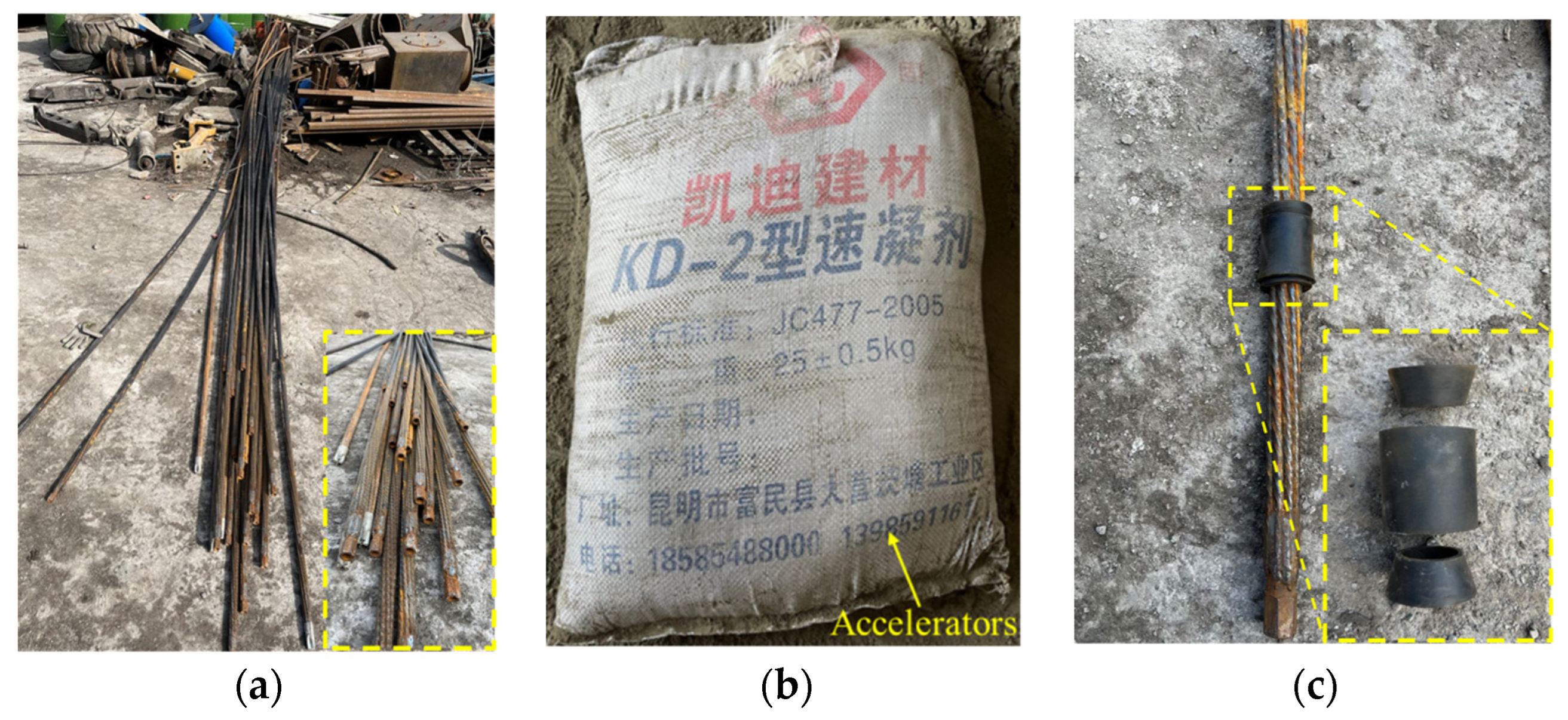

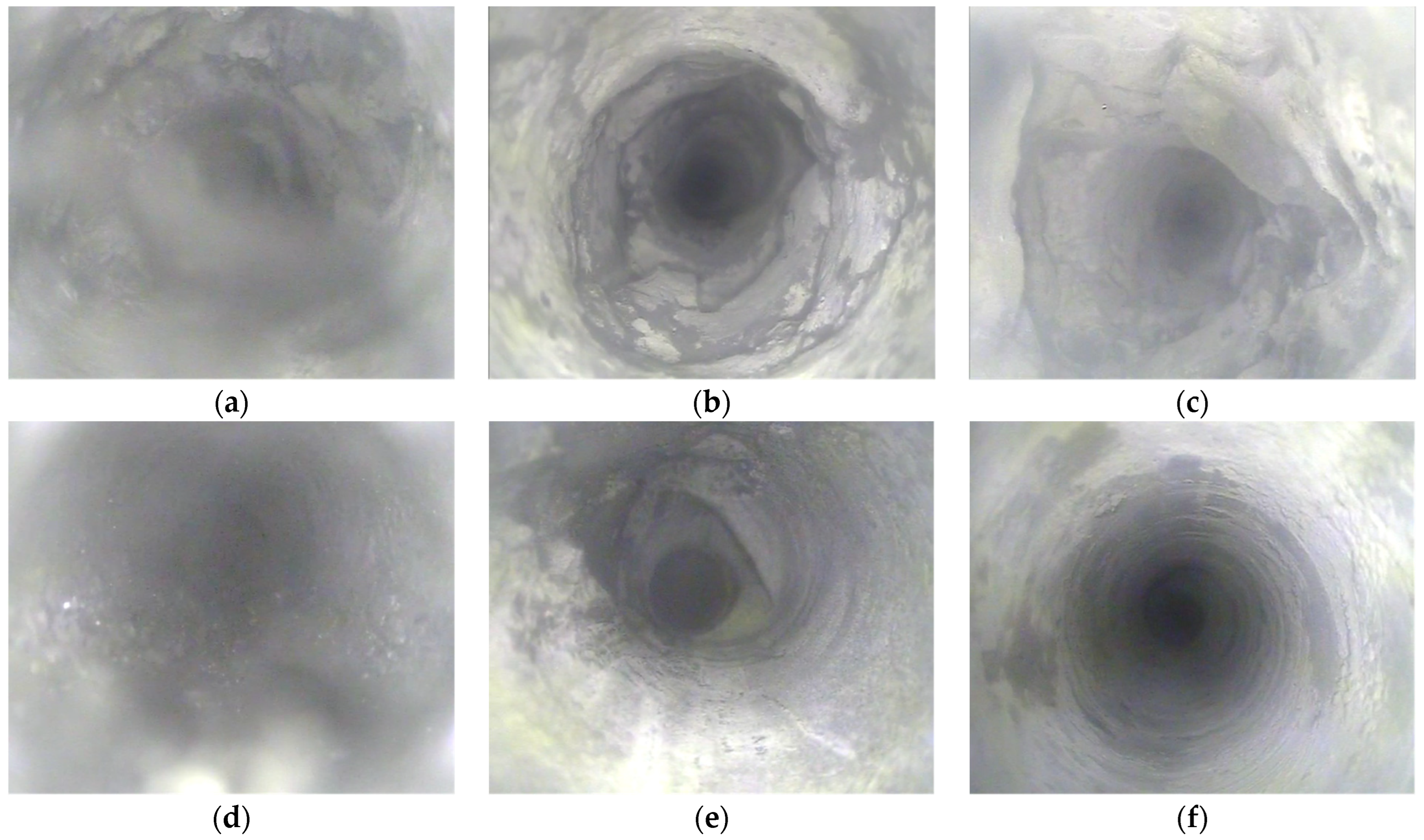

| Lithology | Density (kg/m3) | Bulk (GPa) | Shear (GPa) | Cohesion (MPa) | Friction (°) | Tension (MPa) |
|---|---|---|---|---|---|---|
| overlying strata | 2500 | 12.00 | 7.60 | 2.30 | 28 | 3.00 |
| Fine sandstone | 2325 | 10.85 | 7.00 | 7.90 | 31 | 1.10 |
| argillaceous-siltstone | 2370 | 11.90 | 7.80 | 8.60 | 33 | 1.00 |
| 15#coal | 1395 | 0.75 | 0.23 | 0.21 | 13 | 0.95 |
| argillaceous-siltstone | 2370 | 11.90 | 7.80 | 8.60 | 33 | 1.00 |
| Fine sandstone | 2325 | 10.85 | 7.00 | 7.90 | 31 | 1.10 |
| Underlying strata | 2500 | 12.00 | 7.60 | 2.30 | 28 | 3.00 |
| Material | Cross-Sectional Area (m2) | Young (GPa) | Poisson | Moi (m4) | Tension (GPa) | Grout Stiffness (MPa) | Cohesion (MPa) |
|---|---|---|---|---|---|---|---|
| U shaped steel | 6.0 × 10−3 | 2.0 × 103 | 0.3 | 2.0 × 10−8 | - | - | - |
| Anchor cable | 1.5 × 10−3 | 210 | - | 10.0 | 20.0 | 22.0 |
Publisher’s Note: MDPI stays neutral with regard to jurisdictional claims in published maps and institutional affiliations. |
© 2022 by the authors. Licensee MDPI, Basel, Switzerland. This article is an open access article distributed under the terms and conditions of the Creative Commons Attribution (CC BY) license (https://creativecommons.org/licenses/by/4.0/).
Share and Cite
Liu, P.; Gao, L.; Zhang, P.; Wu, G.; Wang, C.; Ma, Z.; Kong, D.; Kang, X.; Han, S. A Case Study on Surrounding Rock Deformation Control Technology of Gob-Side Coal-Rock Roadway in Inclined Coal Seam of a Mine in Guizhou, China. Processes 2022, 10, 863. https://doi.org/10.3390/pr10050863
Liu P, Gao L, Zhang P, Wu G, Wang C, Ma Z, Kong D, Kang X, Han S. A Case Study on Surrounding Rock Deformation Control Technology of Gob-Side Coal-Rock Roadway in Inclined Coal Seam of a Mine in Guizhou, China. Processes. 2022; 10(5):863. https://doi.org/10.3390/pr10050863
Chicago/Turabian StyleLiu, Pengze, Lin Gao, Pandong Zhang, Guiyi Wu, Chen Wang, Zhenqian Ma, Dezhong Kong, Xiangtao Kang, and Sen Han. 2022. "A Case Study on Surrounding Rock Deformation Control Technology of Gob-Side Coal-Rock Roadway in Inclined Coal Seam of a Mine in Guizhou, China" Processes 10, no. 5: 863. https://doi.org/10.3390/pr10050863






